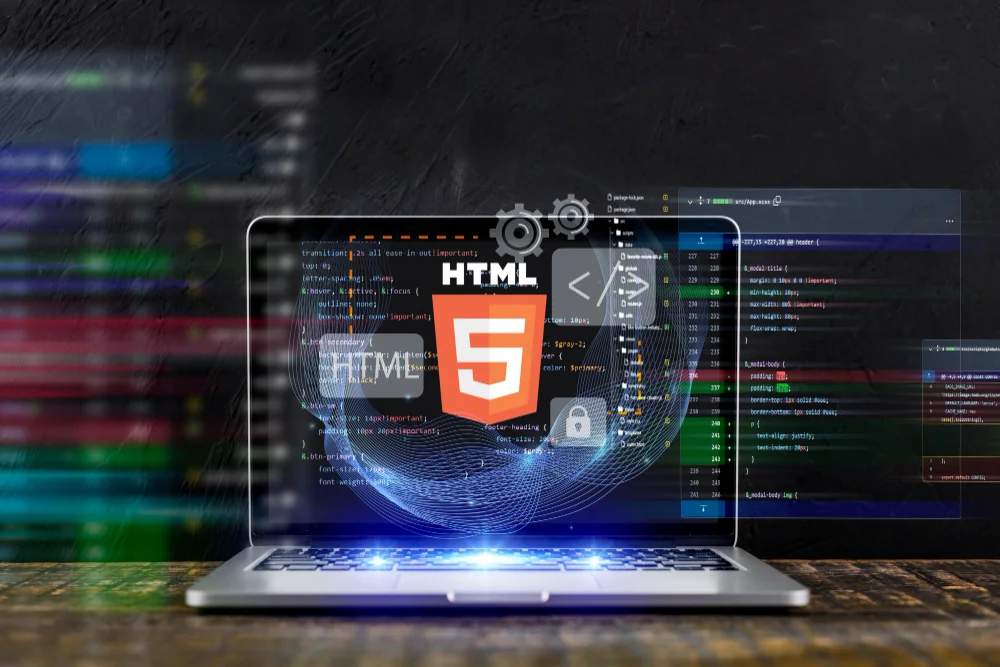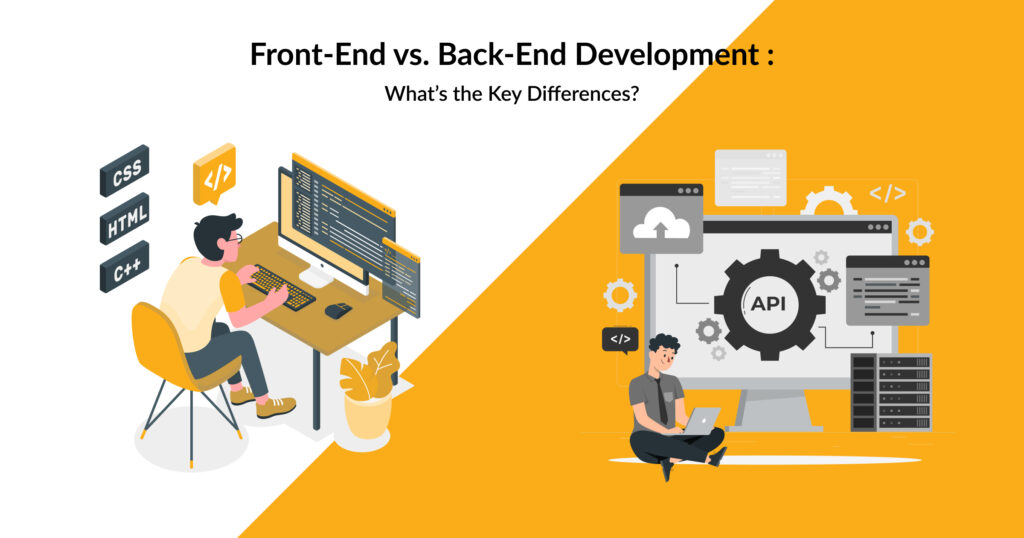Introduction to Backend and Frontend
Understanding the Backend and Frontend: Breaking Down the Key Differences
Welcome to our blog post, where we dive into the world of web development and unravel the mysteries behind the backend and frontend. If you’ve ever wondered how websites come to life, this article is for you!
In today’s digital age, every website you visit is a harmonious symphony of code working together seamlessly. But what exactly goes on behind the scenes? That’s where the backend comes in. It’s like the engine that powers a car, hidden away but essential for everything to run smoothly.
On the other hand, frontend development is all about creating an irresistible user experience. Think of it as the face of a website – beautiful, interactive, and captivating. In this article, we’ll explore these two crucial components of web development in detail, uncovering their differences and highlighting their unique roles.
So buckle up as we embark on this enlightening journey through cyberspace! Let’s start by looking closely at what makes up the backend in web development.
The Role of Backend in Web Development
Regarding web development, the backend is crucial in ensuring everything runs smoothly behind the scenes. While the frontend focuses on creating an engaging user interface, the backend handles all the behind-the-scenes work that seamlessly makes a website or application function.
In simple terms, the backend is responsible for managing data and logic. It involves handling server-side programming, database management, and ensuring smooth communication between different parts of a website or application. The backend serves as the foundation upon which everything else is built.
One of the backend’s key tasks is to process user requests and respond with relevant information. This can include retrieving data from databases, performing calculations or computations, and generating dynamic content based on user inputs.
Developers use various programming languages such as Python, Ruby, Java, and PHP to carry out these tasks effectively. These languages are often paired with frameworks like Django (Python), Ruby on Rails (Ruby), Spring (Java), and Laravel (PHP), which provide additional tools and libraries to streamline development processes.
Additionally, security is another important aspect managed by the backend. With increasing cyber threats and vulnerabilities online today., developers need to implement robust security measures within their applications. This includes encryption algorithms for secure transmission of data and protecting against potential attacks like SQL injections or cross-site scripting.
Overall, the backend development role must be considered in web development projects.
The functionality, stability, and performance largely depend on its efficient implementation.
With a well-structured backend system, a website can handle complex operations or interact with databases efficiently.
That’s why coordination between frontend designers and developers ensures seamless integration, resulting in highly functional websites!
Programming Languages and Frameworks Used in Backend Development
Regarding backend development, there are a variety of programming languages and frameworks that developers can choose from. Each language and framework has its own unique features and benefits, allowing developers to tailor their backend solutions to fit the specific needs of their projects.
One popular programming language used in backend development is Python. Known for its simplicity and readability, Python allows developers to write clean code quickly. With frameworks like Django or Flask, developers can easily build robust web applications.
Another commonly used language is JavaScript. While JavaScript is often associated with frontend development, it also has a strong presence on the backend thanks to frameworks like Node.js. This allows for seamless communication between the frontend and the server-side operations.
For high-performance solutions, languages like Java or C# may be preferred. These languages are known for their speed and scalability, making them suitable for large-scale enterprise applications.
Ruby is another popular choice among backend developers due to its elegant syntax and extensive collection of libraries through the Ruby on Rails framework. This combination enables rapid prototyping and efficient development processes.
The programming language and framework choice depend on project requirements, developer expertise, scalability needs, and performance considerations.
In conclusion, there are numerous programming languages and frameworks available for backend development. Each one offers unique advantages that cater to different project requirements. Whether you opt for Python’s simplicity, JavaScript’s versatility, Java or C#’s performance capabilities, or Ruby’s elegance, the key is finding the right toolset to deliver effective backend solutions. By understanding these options, developers can make informed decisions that will ultimately lead to successful web application implementations

Key Features and Functions of the Backend
The backend of a website is like the hidden engine that powers everything behind the scenes. While users interact with the frontend, the backend handles all the heavy lifting and makes things happen. So, what are some key features and functions of the backend? Let’s dive in!
One important aspect of backend development is data storage and management. The backend uses databases to store information securely and efficiently. Whether it’s user profiles, product listings, or blog posts, the backend ensures that all data is organized and accessible when needed.
Backend developers also handle user authentication and security measures. They implement login systems, password encryption techniques, and other authentication protocols to ensure that only authorized users can access certain parts of a website.
Another crucial function of the backend is handling business logic. This includes processing transactions, calculating prices for products or services, generating reports based on user inputs, and performing complex calculations necessary for various functionalities.
API integration is another key feature of the backend. It allows different applications to communicate with each other seamlessly by exchanging data through APIs (Application Programming Interfaces). Backend developers work on integrating third-party services such as payment gateways or social media platforms into websites.
Scalability is also a major consideration in backend development. As a website grows in terms of traffic and functionality requirements increase over time – scalability becomes essential for smooth operations without compromising performance.
While users may not directly interact with it – understanding these key features helps us appreciate how much goes on behind the scenes to make websites functional! Without an efficient backbone handled by skilled backend developers – even visually stunning frontends would fail to deliver seamless experiences.
The Role of Frontend in Web Development
Regarding web development, the frontend is crucial in creating an engaging and user-friendly interface for website visitors. It is responsible for everything users see and interact with on a website.
Frontend developers use programming languages such as HTML, CSS, and JavaScript to build the visual components of a website. They work closely with designers to bring their vision to life by translating static design files into dynamic web pages.
One key function of the frontend is ensuring responsive design, which means that websites adapt seamlessly across different devices and screen sizes. This involves implementing techniques like media queries and flexible layouts to create a consistent user experience regardless of whether someone uses a desktop computer or mobile device.
Another important aspect of front-end development is optimizing performance. Frontend developers strive to minimize load times by optimizing code, compressing images, and leveraging caching techniques. This ensures that websites load quickly and efficiently for an optimal browsing experience.
Accessibility is another critical consideration in front-end development. Developers need to ensure that websites are accessible to people with disabilities by following best practices such as providing alternative text for images, using proper heading structure, and designing with color contrast guidelines in mind.
The frontend serves as the bridge between design and functionality in web development. It combines aesthetics and usability to create visually appealing websites that are intuitive for users to navigate.
Stay tuned for our next blog section to explore the differences between backend and frontend development!
Programming Languages and Frameworks Used in Frontend Development
When it comes to front-end development, there are several programming languages and frameworks that developers can choose from. Each language and framework has features and advantages, allowing developers to create dynamic and interactive user interfaces.
One of the most popular programming languages for front-end development is JavaScript. It is a versatile language that allows developers to add interactivity to web pages. JavaScript works seamlessly with HTML and CSS, making it an essential tool for building modern websites.
In addition to JavaScript, frameworks like React.js, AngularJS, and Vue.js simplify the process of building complex user interfaces. These frameworks provide a structured way of organizing code and offer reusable components that help speed up development time.
HTML (Hypertext Markup Language) is another foundational language used in frontend development. It provides the structure or skeleton of a webpage by defining elements such as headings, paragraphs, images, links, etc.
CSS (Cascading Style Sheets) complements HTML by adding styling properties to web pages. It enables developers to control a website’s layout, colors, fonts, animations, and other visual aspects.
With advancements in technology, new tools like TypeScript have emerged as well. TypeScript is a superset of JavaScript that adds static typing capabilities, which helps catch errors early on during development.
Choosing the right combination of programming languages and frameworks for frontend development depends on project requirements, developer preference, scalability needs, etc. The key is selecting tools that enhance productivity while delivering an exceptional user experience.
Key Features and Functions of the Frontend
The frontend of a website is what users see and interact with. It encompasses all the elements visible on a webpage, including the layout, colors, images, and text. The key features of the frontend are designed to enhance user experience and make the website visually appealing.
One important function of the frontend is responsiveness. Websites need to adapt to different screen sizes and devices to provide a seamless browsing experience for users. This involves using responsive design techniques such as media queries and flexible grids.
Another essential feature is interactivity. The frontend allows users to interact with various web page elements through buttons, forms, dropdown menus, sliders, and more. This functionality enables users to input data or perform actions like adding items to a shopping cart or submitting a contact form.
Frontend development also focuses on optimizing performance by minimizing loading times. This can be achieved through techniques like code optimization, image compression, lazy loading of resources, and caching.
Accessibility is another crucial aspect of frontend development. Websites should be designed to cater to all types of users regardless of their abilities or disabilities. This includes providing alternative text for images, using proper headings for content structure, ensuring keyboard navigation compatibility, and implementing other accessibility guidelines.
Lastly, user interface (UI) design is important in front-end development.
It involves creating intuitive layouts, using consistent branding elements, and choosing appropriate typography.
UI designers leverage creative tools like Adobe XD Sketch Figma to wireframe prototypes before turning them into fully functional websites.
They also consider usability principles when designing interfaces to create an easy-to-navigate website.
In conclusion, the frontend serves as the face of a website.
The key features it offers encompassing responsiveness, interactivity, optimum performance, accessibility, and UI design, collaborate together to create an engaging user experience that keeps visitors coming back for more

Differences between Backend and Frontend
When it comes to web development, understanding the differences between the back and frontend is crucial. These two aspects create a seamless user experience on websites and applications. Let’s dive into the key distinctions between the backend and frontend.
Backend development refers to the server side of an application or website. It involves writing code that runs on the server, handling tasks such as data storage, processing requests, and managing databases. Developers working on the backend use programming languages like Python, Ruby, Java, or PHP, along with frameworks like Django or Ruby on Rails.
On the other hand, frontend development focuses on creating the visual interface that users interact with directly. Frontend developers utilize HTML for structure, CSS for styling elements, and JavaScript for adding interactivity to websites. Popular frameworks like ReactJS or AngularJS are also employed in building complex user interfaces.
The main difference lies in their respective functions: while the backend handles behind-the-scenes operations like data management and communication with servers through APIs (Application Programming Interfaces), the frontend deals with designing layouts, ensuring responsiveness across devices, and making sure everything looks visually appealing.
Coordination between backend and frontend teams is crucial because they have distinct responsibilities but must work together seamlessly. Backend developers provide APIs, allowing frontend developers to access server data while frontend developers integrate these APIs into their designs.
Understanding how both backend and frontend contribute to web development can help businesses build robust applications that deliver a great user experience. So whether you’re interested in becoming a developer or hiring a team for your project – knowing these differences will be valuable!
Importance of Coordination between Backend and Frontend
Coordination between the backend and frontend is crucial in web development to ensure a seamless user experience. While the backend focuses on server-side processes and data management, the frontend deals with the presentation layer users interact with.
Both aspects must work together harmoniously for a website or application to function effectively. The backend developers provide APIs (Application Programming Interfaces) that allow communication between the server and client-side components. This enables data retrieval, storage, and processing.
On the other hand, frontend developers utilize these APIs to create intuitive interfaces that are visually appealing and user-friendly. They handle tasks such as designing layouts, implementing animations, handling user input validation, and displaying dynamic content.
Coordinating between backend and frontend teams ensures efficient collaboration throughout the development process. Regular communication helps address potential issues or conflicts before they escalate into larger problems that can impact functionality or performance.
Furthermore, coordination allows for better optimization of resources by avoiding duplication of efforts. It ensures that both sides are aligned regarding design choices, technological dependencies, and overall project goals.
In addition to technical considerations, coordination also plays a role in maintaining consistency across various platforms or devices on which an application may be accessed. Ensuring responsive designs across different screen sizes requires close cooperation between frontend designers/developers and their counterparts working on the backend.
Effective coordination leads to improved user satisfaction by delivering a cohesive product where all elements seamlessly integrate. By bringing together their expertise from different domains – programming languages/frameworks used in each aspect – backend developers can focus on building robust systems. At the same time, frontend specialists concentrate on creating engaging user experiences.
Conclusion
Understanding the differences between backend and frontend is crucial in web development. Both components play essential roles in creating a functional and visually appealing website.
The backend handles the behind-the-scenes work, managing data, processing requests, and ensuring smooth functionality. It utilizes programming languages like Python, Java, Ruby on Rails, and frameworks like Django or Laravel.
On the other hand, the frontend focuses on user interaction with the website. It brings designs to life using HTML for structure, CSS for styling, and JavaScript for interactivity. Popular frameworks include React.js and Angular.js.
While backend deals with server-side operations and data management, frontend works directly with users through visuals and user-friendly interfaces. These two components must work together seamlessly to create a cohesive web experience.
Coordination between backend developers and frontend designers is essential for successfully implementing features. Effective communication ensures that design elements are incorporated into the final product while maintaining efficient functionality.
In conclusion,
Backend and frontend may be distinct areas of web development, but they rely heavily on each other’s strengths to create an exceptional end result. Understanding their key differences allows developers to optimize performance while providing users an engaging experience.
Both aspects require skilled professionals to navigate complex coding languages or visualize captivating designs. Whether you’re building a small business website or a large-scale application – recognizing the important role played by both these components will lead to better outcomes in your web development projects!

